Emirates and the United Kingdom were seemingly in a happy marriage, as the Dubai-based airline increased its presence in the British Isles over the last couple of years with new destinations and increased capacity to previously served airports.
“The UK is one of the most profitable markets on our network,” stated the President of Emirates Tim Clark in an interview in 2019. “We have continued to witness growth both in terms of capacity, in terms of profits, and in terms of points served over the last three, four, five years. It is a really strong story for us,” added Clark.
But could have the coronacrisis exposed weaknesses in the marriage story between the two?
After all, the airline was one of the most exposed companies in aviation. Along other hub-and-spoke-based airlines, as well as its nearby rival Qatar Airways or the South East Asian giant Singapore Airlines (SIA1) (SINGY) to name a few, the carrier had no optimal domestic network to support its operations at least on a smaller scale. The all-wide-body fleet operator had no choice but to completely suspend its passenger operations in March 2020.
The importance of the United Kingdom market
In April 2020, Emirates resumed small-scale operations with its Boeing 777 fleet, as the company’s 115 A380s sat on the ground, waiting for better days to come. London-Heathrow (LHR) was amongst the list of the airline’s first five destinations after the suspension of its operations, as the airline announced four weekly flights to the British capital. The four other cities received a tri-weekly flight.
In June 2020, more destinations were added, including Manchester Airport (MAN) and Glasgow Airport (GLA).
When its flagship Airbus A380 returned to the skies on July 15, 2020, the aircraft first landed in LHR. The same day, the Emirati airline announced its intentions to increase the capacity between Dubai and London by adding another A380 to the route, increasing the frequency to two flights per day.
But even prior to the pandemic, the United Kingdom was a crucial market, as highlighted by the fact that London is the most popular city in its network, noted Clark in an interview with FlightGlobal. OAG estimated that Emirates’ Dubai International Airport (DXB)-London Heathrow Airport (LHR) route generated $796 million of revenue throughout 2018/2019. During the same year, Emirates generated AED78.5 billion ($21.3 billion) of revenue.
The airline looked to expand its presence further at LHR, yet was denied. Airport Coordination Limited (ACL) data shows that Emirates unsuccessfully applied for four additional slots at London’s busiest airport for the Winter 2020 season. ACL’s documents show that airlines were not given permission to use 11,176 of the allocated slots due to runway constraints at the airport.
Never-ending turbulence?
“Going forward, we are looking very carefully at what happens with the third runway at Heathrow,” stated Clark. “Obviously, with this kind of demand and the peaks that we are experiencing, we would like to have more slots at Heathrow.”
The expansion of the busiest airport of Europe, however, has hit roadblock upon roadblock . Prior to the crisis, the timeline to build an additional runway at LHR was set to either early-2028 or late-2029. But the COVID-19 pandemic set forth another roadblock in the airport’s road to do so.
“Given the current COVID-19 crisis and the ongoing appeals process, we expect the opening of the third runway to be delayed by at least two years,” stated LHR’s management H1 2020 report. Seemingly, the only option for Emirates to expand its operations to London is either operate to other airports, like Stansted (STN) or Luton (LTN), as Gatwick Airport is also overflowed with traffic. Much like at Heathrow, ACL denied the usage of 11,299 slots due to runway constraints.
The COVID-19 crisis has also brought up the questionable policy of the United Kingdom’s government. So much so, that the executives of British Airways, easyJet, and Ryanair came together to sue the lawmakers over the then-newly announced quarantine policy in June 2020.
We will support any legal action launched by IAG against this UK’s ineffective and useless visitor #quarantine
— Ryanair Press Office (@RyanairPress) June 7, 2020
In July 2020, the trio ended the legal proceedings, as the UK government relaxed the rules and introduced a list of safe countries whereupon a person does not need to self-isolate for 14 days.
“Today’s publication of a list of countries is the first step. We look forward to the publication of the rationale behind the decision-making and the continued lifting of the quarantine from safe countries,” the airlines said in a statement.
Neither United Arab Emirates nor Dubai made the list, last updated on July 31, 2020. Nevertheless, Emirates has scheduled three daily flights to LHR alone, with additional flights to Manchester (MAN) and Glasgow (GLA) spread throughout the week in August 2020.
AeroTime News approached Emirates regarding its current operations in the United Kingdom.
The current crisis was preceded by the uncertainty of Brexit. The United Arab Emirates is one of the largest export markets in the Middle East for the United Kingdom. How smooth the process of Britain exiting the European Union had major implications for both the UAE and the UK. Ensuring a steady flow of air traffic and trade was essential, considering how important the aviation market is for both Emirates and Etihad, another UAE-based airline. But the uncertainty of Brexit has not swayed away Emirates from growing its operations in the United Kingdom. Neither did it sway away passengers from traveling between the two, as indicated by Clark’s comments.
But does Emirates even have an option to divorce, considering the importance of the market?

